Wandering through the junior section of the Palo Alto mall after Christmas this year, my stepsister Holly noticed the suggestive nature of some of the brands. We took pictures:
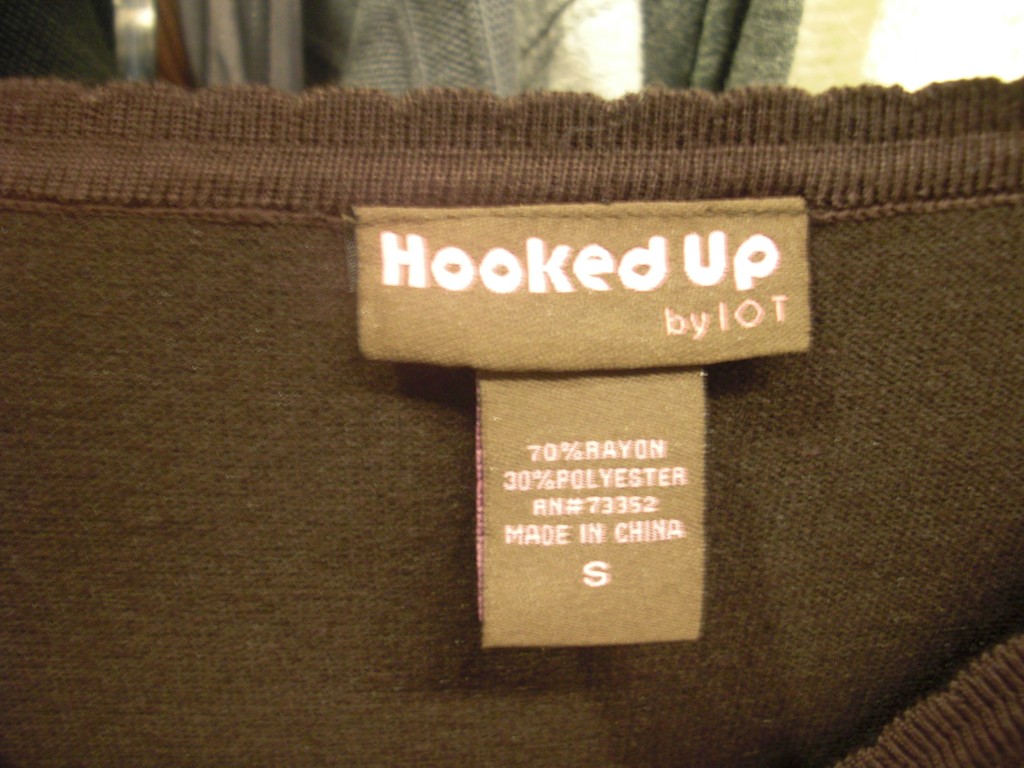
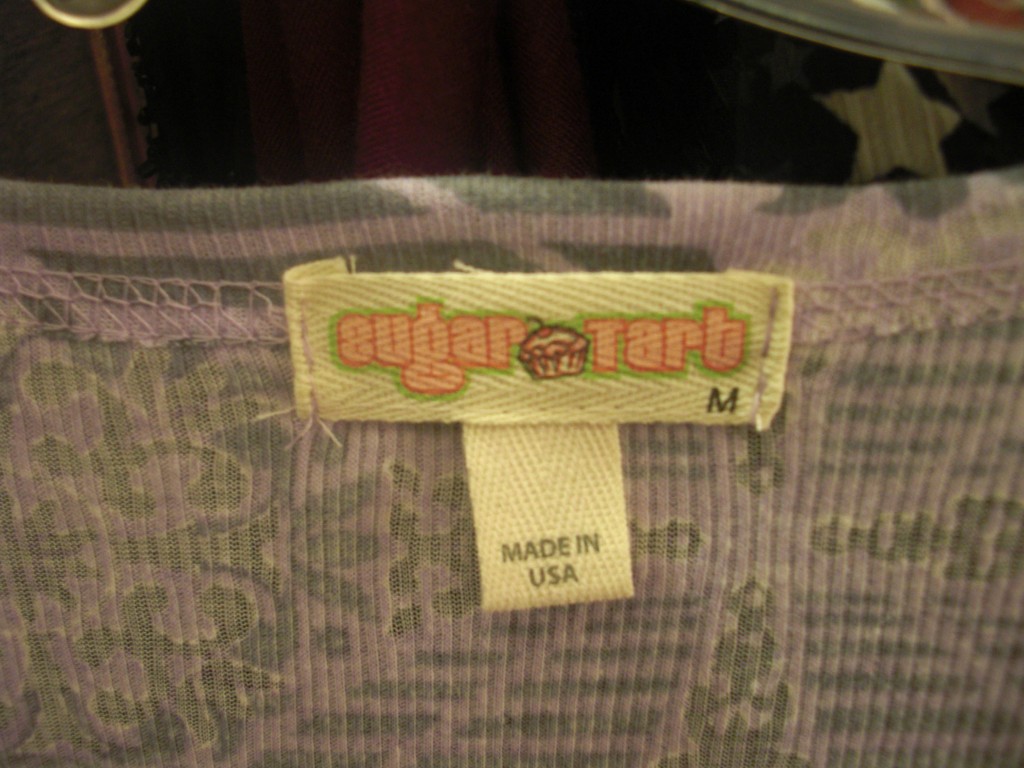
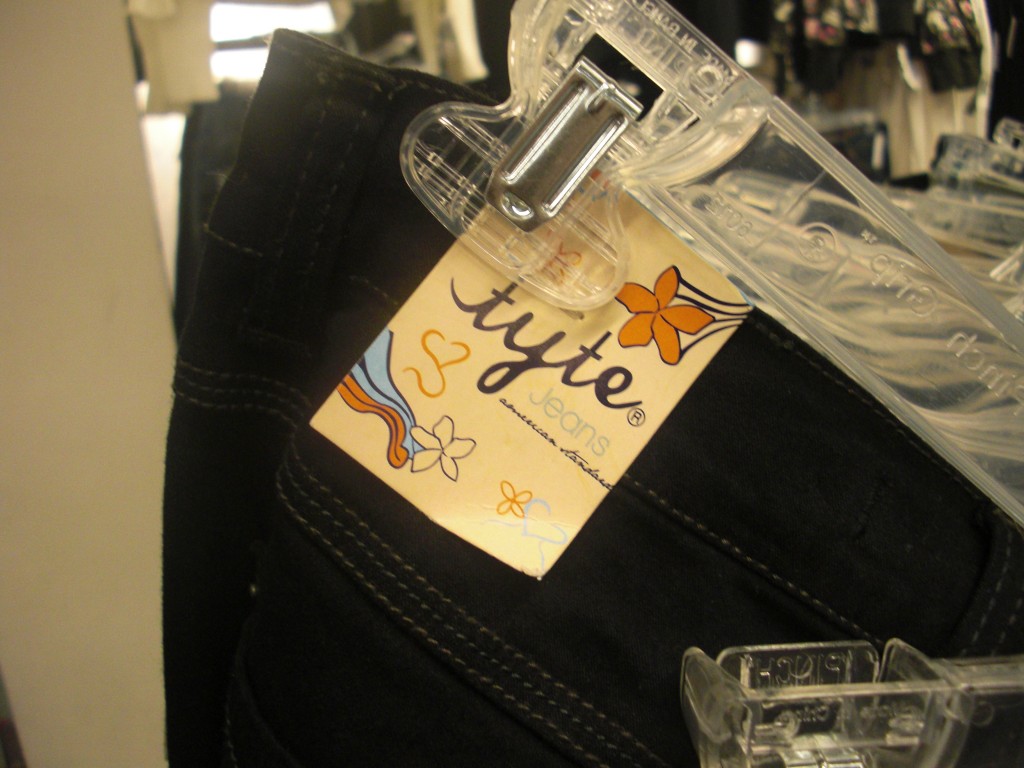
Wandering through the junior section of the Palo Alto mall after Christmas this year, my stepsister Holly noticed the suggestive nature of some of the brands. We took pictures:



Lauredhel of Hoyden about Town sent in this ad for Brighton Grammar School, an Anglican boys’ school in Australia:
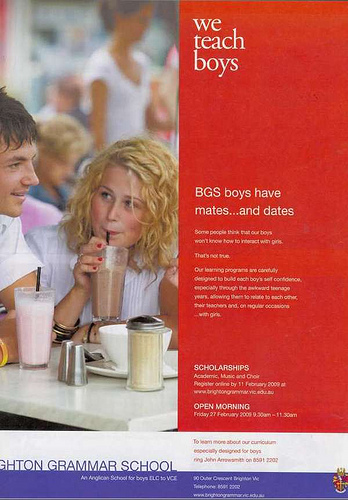
Text:
BGS boys have mates…and dates. Some people think that our boys won’t know how to interact with girls. That’s not true. Our learning programs are carefully desgined to build each boys self confidence, especially through the awkward teenage years, allowing them to relate to each other, their teachers, and, on regular occasions…with girls.
Huh. I like how they’re using the promise of access to girls to market the school. And indeed, it appears that they do teach boys things, including to expect cute girls to gaze at them adoringly.
I don’t know much about the assumptions surrounding all-boys or all-girls schools. Is there a belief that kids who go to them won’t be able to interact with the other sex? Or is this about fears parents have about homosexuality at all-boys schools? Is the school letting them know they don’t have to worry because their sons will have tons of opportunities to hang out with pretty girls?
Margaret McE. sent in an image of Gro-Shu kids’ shoes (found at Hoyden About Town), which are sold at Payless Shoes in Australia. They’re a great example of the gendering of products: notice that the boys’ shoe is called Maths and the girls’ is Drama.

I mean, really?
Taylor D. sent in a link to a collection of vintage ads that includes this one:
From Vintage Ads:
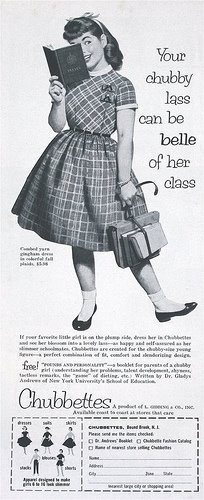
Holly M. sent us this one:
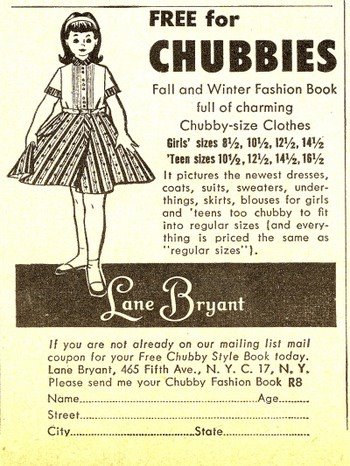
NEW! Larry Harnisch, of The Daily Mirror, sent us this one:

The fact that these girls were considered “chubby” is only slightly more distressing than the fact that polyester blends were considered fashionable.
What do they call sizes for “larger” kids these days? I know they don’t say “chubby,” but I don’t think they use the “plus-size” term for kids–am I wrong? Is there a standard industry term?
Francisco pointed us to a spoken word poem by Andrea Gibson in which she talks about what it’s like to be ambiguously gendered:
Transcript (borrowed from Francisco):
So, I teach in a preschool. Hehe… I make a goddamn difference, now what about you. That’s one point I had to make before I read this poem. The second point is, I usually have hair that is much much shorter than this. That’s all you need to know.
“Are you a boy or a girl?” he asks, staring up at me in all three feet of his pudding face grandeur, and I say “Dylan, you’ve been in this class for three years and you still don’t know if I’m a boy or a girl?” And he says “Uh-uh.” And I say “Well, at this point, I don’t really think it matters, do you?” And he says “Uhhhm, no. Can I have a push on the swing?” And this happens every day. It’s a tidal wave of kindergarten curiosity rushing straight for the rocks of me, whatever I am.
And the class, when we discuss the Milky Way galaxy, the orbit of the Sun around the Earth… or whatever. Jupiter, Saturn, Mars, and kids, do you know that some of the stars we see when we look up in the sky are so far away, they’ve already burned out? What do you think of that? Timmy? “Umm… my mom says that even though you got hairs that grow from your legs, and the hairs on your head grow short and poky, and that you smell really bad, like my dad, that you’re a girl.” “Thank you, Timmy.”
And so it goes. On the playground, she peers up at me from behind her pink power puff sunglasses and then asks, “Do you have a boyfriend?” And I say no, and she says “Oh, do you have a girlfriend?” And I say “No, but if by some miracle, twenty years from now, I ever finally do, then I’ll definitely bring her by to meet you. How’s that?” “Okay. Can I have a push on the swing?”
And that’s the thing. They don’t care. They don’t care. Us, on the other hand… My father sitting across the table at Christmas dinner, gritting his teeth over his still-full plate, his appetite raped away by the intrusion of my haircut, “What were you thinking? You used to be such a pretty girl!” Frat boys, drunken, screaming, leaning out of the windows of their daddys’ SUVs, “Hey! Are you a faggot or a dyke?” And I wonder what would happen if I met up with them in the middle of the night.
Then of course there’s always the somehow not-quite-bright enough fluorescent light of the public restroom, “Sir! Sir, do you realize this is the ladies’ room?” “Yes, ma’am, I do, it’s just that I didn’t feel comfortable sticking this tampon up my penis in the men’s room.”
But the best, the best is always the mother at the market, sticking up her nose while pushing aside her daughter’s wide eyes, whispering “Don’t stare, it’s rude.” And I want to say, “Listen, lady, the only rude thing I see is your paranoid parental hand pushing aside the best education on self that little girl’s ever gonna get, living with your Maybelline lipstick after hips and pedi kiwi, vanilla-smelling beauty; so why don’t you take your pinks and blues, your boy-girl rules and shove them in that car with your fucking issue of Cosmo, because tomorrow, I stop my day with twenty-eight miles and I know a hell of a lot more than you. And if I show up in a pink frilly dress, those kids won’t love me any more, or less.”
“Hey, are you a boy or a — never mind, can I have a push on the swing?” And some day, y’all, when we grow up, it’s all gonna be that simple.
Below is a video, found via The Daily Dish, of a girl, maybe four or five, mimicking the dancing in a music video featuring Beyonce. She’s amazing! Watch her go:
Wow!
Okay… now for sociological comments… these are all Gwen’s ideas, by the way, even though I’m posting it:
We often think of childhood socialization as a top-down process. That is, we imagine that children are empty vessels and adults, mostly parents maybe, fill them up with whatever they please. It may be true that the parents of this little girl actively, even aggressively, encouraged her to learn this dance. But it’s also possible that this is driven by that little girl. In which case, it may illustrate how kids can take an active part in their own socialization. Clearly these parents don’t mind that their daughter is watching Beyonce, but she may be taking the initiative to emulate a public figure she’s seeing in the media (which surely includes messages about how to look, dress, etc.). Even if these parents don’t like everything about that message (or other models she might follow), they can’t actually protect her from the ever-present messages about femininity that are all around her, which are going to affect how she thinks about herself, what she should be, etc.
Lisa Wade, PhD is an Associate Professor at Tulane University. She is the author of American Hookup, a book about college sexual culture; a textbook about gender; and a forthcoming introductory text: Terrible Magnificent Sociology. You can follow her on Twitter and Instagram.
Lorë P. sent in examples of two stamp sets. She writes:
They are clear plastic you peel and put on blocks in order to stamp images… They are both made by a company called Sassafras Lass and are being sold at Joann Fabrics. One of the stamp sets is called “Girl Talk” and the other is “Boy Talk.”
Lorë did such a wonderful job describing these, I will leave it to her:
One of the first things that struck me was that both of these is that they have stamps that mention dad — “daddy’s girl” and “like father like son” but only the female one mentions mom (I guess it would be considered too emasculating to have “mommy’s boy?”)
Another interesting part of these stamps is that the “Girl talk” emphasizes the sweetness of girls – their giggles, their silliness, their angelic qualities (not to mention princess..). On the other hand, the male version has more objects – trucks, rockets, robots and “strong” traits – being brave and embracing adventure (and what does “all boy” mean anyway?).
The one overlap that I can see is the word “Laughter” – which on the girls segment is in very frilly cursive handwriting and on the male version written in an old cowboy font. This also points to the difference in fonts, where the male versions are more square and has no cursive. The girl version is almost all cursive, except for some very curly printing.
While I am not particularly shocked at finding this kind of stamps available to scrapbookers and cardmakers – I always wonder why we have to make the lines of difference so distinct… Of course these stamps are probably not being used by children, but by adults making things about or for children… of course, these stamps are couched in (from my experience) a predominately female dominated (although pretty conservative) hobby.
Thanks Lorë!
See also this post on gendered Disneyland T-shirts.
Lisa Wade, PhD is an Associate Professor at Tulane University. She is the author of American Hookup, a book about college sexual culture; a textbook about gender; and a forthcoming introductory text: Terrible Magnificent Sociology. You can follow her on Twitter and Instagram.